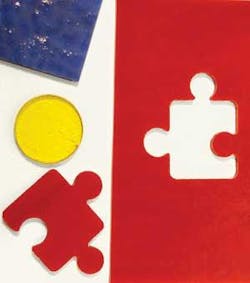
Mukilteo, WA - When cutting glass with a CO2 laser, the best “laser only” applications are typically thin glass substrates in the range of 0.0012-0.0236 inch thick. Without using specialized, and in some cases, proprietary processes, thicker types of soda-lime (float) glass are difficult to laser cut in one step.
The exceptions to the rule are the stained glass samples shown in the photo that cut well using a Synrad (www.synrad.com) sealed CO2 laser. As with standard float glass, straight-line cutting of stained glass is easily done by scoring and snapping. The difficulty is in creating irregular shapes. Traditionally, curved shapes are made by nibbling away at the contour, by grinding on a diamond wheel, or by cutting using a diamond-bladed bandsaw—all of which are time- and labor-intensive processes.
Synrad’s cutting setup for these opaque and translucent stained-glass samples consisted of a Firestar f400 laser with beam delivery provided by an XY flying optics system. Beam focus was through a 2.5-inch positive meniscus lens that provides a 0.004-inch spot with a 0.07-inch depth of focus.
While the addition of metallic oxides or metallic salts to the glass formulation creates the brilliant hues and colors seen in the stained glass, they also appear to alter the glass structure so that the laser’s intense, localized heating does not lead to unintended thermal fracturing of the glass substrate. According to Synrad, cut edges exhibit the same type of striation patterns seen in metal cutting where vaporized and molten material is blown through the cut area by a high-pressure assist gas.
The puzzle piece cut out shown measures 2.25 inches wide by 2.06 inches tall. Cut power was 400 watts at a velocity of 50 inches per minute (IPM). At a constant velocity of 50 IPM, cycle time required to cut the puzzle shape is 7.5 seconds. Synrad used 60 PSI of air as a gas assist during cutting. The discolored dross present on the bottom edge of all cut faces is brittle and easily removed-leaving a clean laser-cut edge.